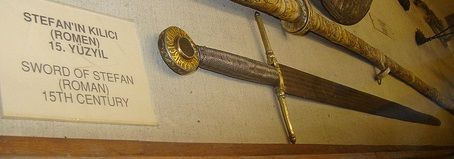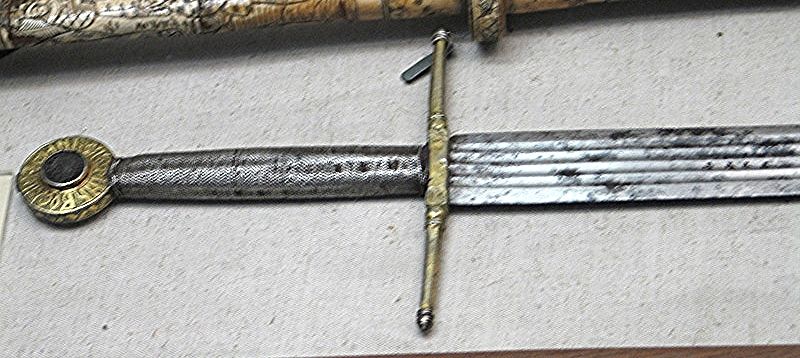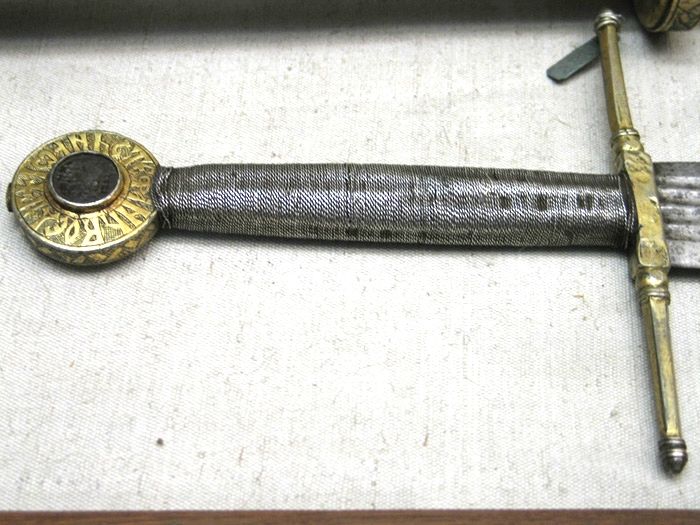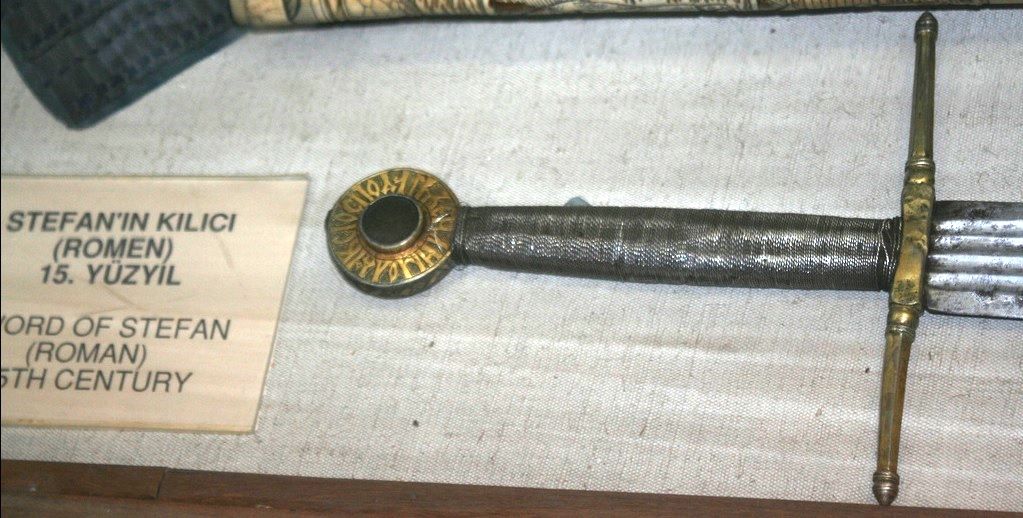Sword of Stephen the Great / Stephen III of Moldavia
Apr 21, 2014 13:42:16 GMT
Post by Jack Loomes on Apr 21, 2014 13:42:16 GMT








...The Romantic posterity turned Stephen the Great into one of the towering figures of history, giving him a place of honor in history textbooks. Many public places all across Romania were named after him, as the staunchest defender of Moldavian independence. In 2006, the Romanian public television station ran a wide-ranging poll, asking Romanians to name what they believed to be the most important figure in Romanian history. Stephen the Great came out the winner. On top of that, in 1992 the Romanian Orthodox Church canonized him, officially making him “Stephen the Great and Holy”.
The one object most famously associated with the ruler is his sword. Historian Carol Konig, expert in medieval weaponry, believes that even though Stephen’s sword has a Western design, it has something peculiarly Moldavian: “There is only one document speaking of Romanian weapons. Stephen the Great, in a letter addressed to Italians, to the Milanese in particular, asks the craftsmen of Milan to manufacture 10 Wallachian swords. This type of Modavian sword can only be the one on display in Istanbul, where there are 3 other similar Romanian swords, of which one has at the top of its handle the inscription ‘I, voivod Stephen’ and the coat of arms of Moldavia. This sword has come to Romania as well; I had the good fortune of doing its paperwork. The sword is not perfect, it has multiple corroded spots, sometimes fairly deep ones. It is also dented, in some places on both sides of the edge.”
The sword now resides in Topkapi Palace, in Istanbul. It is 125 cm long, with the blade measuring 102 cm. The handle is 23 cm long, wrapped in silver cord, and weighs around 2.5 kg. The handle, decorated with Moldavia’s coat of arms, has a disc at the end with the inscription “I, voivod Stephen”, along with a cross. The sword was not the one he used in campaigns, it was ceremonial.
The Moldavian ruler got the sword as a gift from Pope Sixtus the 6th, in 1475, after the battle of Podul Inalt, in recognition of the ruler’s role in defending Christianity. In that battle, a Polish crusader army joined Moldavian and Szekely troops under Stephen’s command, and routed the Ottoman army, led by Suleyman Pasha. In the letter accompanying the gift, the pope wrote: “Your deeds so far, done with wisdom and courage against the infidel Turks, our foes, have brought so much fame to your name that it is on everyone’s lips and are much praised by everyone”.
There are two versions to the story as to how the sword came to be in Turkish possession. One version is that Stephen himself gave the sword to the Sultan shortly before death, in a gesture of fealty towards Ottoman superiority, in his attempt to preserve Moldavia’s independence. The second version is that the sword reached Istanbul during the first reign of Petru Rares, Stephen’s son, who ruled first between 1527 and 1538. The Turks wanted to remove him, because he wanted to join the Hungarian anti-Ottoman initiative, and according to the tale, they sacked Moldavia in 1538, plundering the country’s treasure and taking the sword to their capital.
The sword has never left Turkey. A replica was put on display at the National Art Museum of Romania in 2004, during the celebrations occasioned by the anniversary of five centuries since the death of Stephen the Great. The Turkish government provided the replica as a gift, and it went to the keeping of Putna monastery, the most important religious place built by Stephen the Great, and the place of his burial. In November 2012, another replica of the sword went to the Soroca Museum, in the Republic of Moldova, a gift from the then Turkish Prime Minister, Recep Erdogan.
Source: www.rri.ro/en_gb/stephen_the_greats_sword-2414
By User Mare Rosu of Viking Sword Forum:
Certain unique weapons and armour pieces, most particularly the guns and swords belonging to extraordinary people have undoubtly been the subject of many fantastic stories in their time of deeds of facts but very few have transceded to raise crises or make the news headlines now, past their age of glory, such as this one...
So, here is a different lecture in the Forum, a contemporary story, a live happening and long expected event by many, including myself ...
Ever since I was a kid back in my Transylvanian homelands I was fascinated by the figur and life of one of our Romanian medieval rulers, Stephen the Great, known to us Romanians as Stefan cel Mare.
He was the quintesential Moldavian medieval ruler (1457-1504), he embodied the national spirit and the archetype of the Eastern European, at the time he was mainly famous as crusader against expanding imperial Ottoman forces but he also fought succesfully or less against other threatening neighbours like Poland or Hungary, at times friends rather than enemies however. As the very complicated web of political interests in a gothic medieval age dictated, he was friend or foe to even with his relatives, like the infamous ruler of Wallachia, Vlad The Impaler, or Dracula, as he mistankelly remains baptised by the history.
So, many battles and campaigns have been fought and won consistently by this arguably righteous and legendary autocrat in the name of his people, for posterity bringing him even the status of Saint by the local Greek-Orthodox church of Romania few years ago and therefore named is now canonised as Stephen the Great and Holly (Stefan Cel Mare si Sfant).
Late in life, his power grew weak like his health and so was the country in the end paying tribute but not ceased to lose the soveranity of its country. However, one remarcable things he did lost to the Ottoman army (undated and untold) and that was his famous weapon, THE BATTLE SWORD.
Stephen the Great, ironically, was not a man of an imposing physique appearance, rather short but still muscular and with a pleasant face. His sword, unlike him, a very stylish monarch of Bysantine fashion, rivaling if not surpasing many courts of western Europe, was a plain and fairly large straight, classic, European medieval steel with a 102 cm blade and a total length of 125 cm. Simple, grooved, yet sober and imposing the sword was little personalised with perhaps the only exception of ring like pommel bearing the following aproximate cyrilic inscription in archaic Romanian ,,IO STEFAN, VOIVOD AL MOLDOVII,, meaning : I, Stephen, the ruler of Moldavia. This almost mythical, battle forged sword, became more or less claimed by Romanians as a national trasure and symbol; Stephen used to hold it like a cross by the edge after the battle announcing a Christian victory.
Later in time, the Turks however, took it as war booty and spectacular trophy, triumphantly presented to the sultan who deposited with the most prized treasures at the Royal Palace in Istanbul, today`s Topkapi National Museum of Turkey, where the sword still remains in display, secondary in importance to only some pieces like the swords of Prophet Mohammed, also in exhibit there.
Romanians, in this last decade, personally or trough cultural and historical societies started presurising their own government to request and negociate the retutn of this national symbol.
As a result of this much mediated national crisis, in the year 2001 situation became so critical that contacts have been made at the highest political level from both president of Romania. Mr. Ion Iliescu and his ,,adverse,, counterpart, Mr. Ahmet Necdet Sezer, the president of Turkey. Hence, international negotiations began imediatelly but even so, the only one most notable result by far was the temporary loan of Stephen the Great`s sword from Topkapyi Sarayi Museum in Istanbul to the National Art Museum of Romania in Bucharest. That happened in July 2004, exactly 500 years after the death of Stephen the Great, so after half a millenium the extremelly disputed weapon revisited homeland, alongside other two Moldavian nobiliary swords from the same period . With this bycentenial ocassion from his death other exhibitions in Paris, Vatican and other important cities were hosted.
No sign however yet from the Turkish government to announce intentions of return of this national treasures, still the festivities underwent peacefully in a happy celebration of both rich national heritages, leaving behind any historical rivalry as the president of Romania stated : "The presence in Bucharest of Stephen the Great's battle sword represents an important moment in the bilateral relations between the two countries, confirming over the centuries the ruler's vision about the need for tight relations between the two nations" ... "Stephen the Great's deeds are a model and a yardstick for his successors. He was a man of his times"...""At the moment, the sword is playing a different role. It is a link between two countries and peoples in one of the most difficult battles, that for building a world of reason, security, peace and wisdom" while the head curator of the National Art Museum Mrs. Roxana Theodorescu affirmed: ""I believe that this is the most important event of the year 2004, the year devoted to Stephen the Great" ... And commentaries went on and on from TV, journals and countless VIP`s : ministers, diplomats, historians and artists each one with its own opinion and speech... Still I wasnt there to take a picture of the sword and could not find one anywhere ...
For more information on Oakeshott Type XII Swords see this extract of Ewart Oakeshott's Records of the Medieval Sword: www.sword-site.com/thread/128/oakeshott-type-records-medieval-sword
Wikipedia article regarding Stephen III of Moldavia: en.wikipedia.org/wiki/Stephen_III_of_Moldavia
Sources:
www.vikingsword.com/vb/showthread.php?t=53
www.onaltiyildiz.com/artikel.php?artikel_id=292

.png?width=1920&height=1080&fit=bounds)